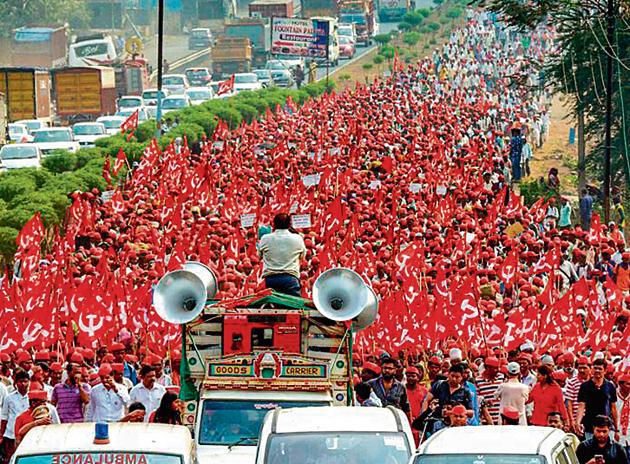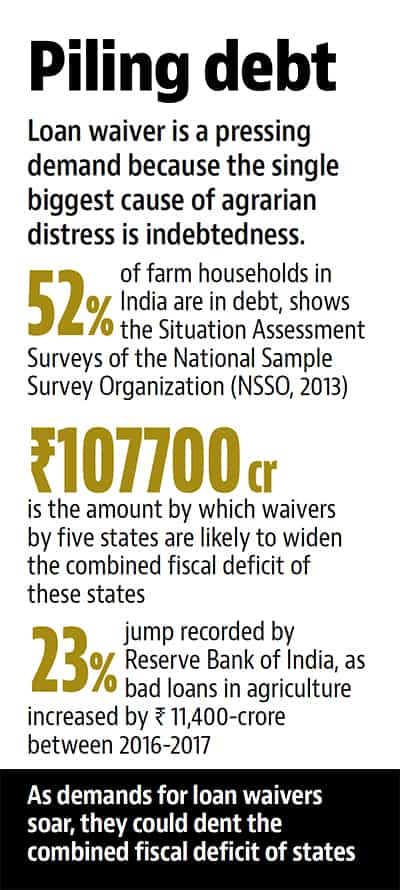Why a farm loan waiver is the holy grail
Farm protests have seldom been so strong, but in Maharashtra in March, 35,000 farmers walked 180 km on a “long march” to reach Mumbai from the state’s Nashik district seeking loan waivers — a turnout not seen since the days of Tikait’s agitation.
On an October afternoon in 1988, Mahendra Singh Tikait, a rustic and hardy farm leader from western Uttar Pradesh, stormed Delhi with his men. They came in a fleet of lumbering tractors, around 80,000 peasants, cattle, hay to be used as bedding and foodgrains to see them through an unrelenting protest.

It was the scene of a spectacular rural takeover of Delhi. Tens of thousands of farmers erected tents, slept, cooked food and ate in the open as well as defecated there, laying siege to the Boat Club lawns, a stone’s throw from Parliament. They vowed to not budge until their demands for higher sugarcane prices and a waiver of electricity charges were met.
Tikait’s Bhartiya Kisan Union successfully extracted key concessions from the then Rajiv Gandhi-led government.
Farm protests have seldom been so strong, but in Maharashtra in March, 35,000 farmers walked 180 km on a “long march” to reach Mumbai from the state’s Nashik district seeking loan waivers — a turnout not seen since the days of Tikait’s agitation.
“Farm loan waivers have now become the new rallying point for farmers’ movement because there are just losses, losses everywhere,” says Amra Ram, a leader of the All-India Kisan Sabha, the organisation that led the “long march”.
Under the NDA government, farmers haven’t fared too well due to a combination of factors, including two successive droughts and a slump in global food prices. This has led farmers’ groups and lobbies to re-energise themselves around two key demands — loan waivers and profitable prices.
“Don’t call it a protest. Ours is a political movement of farmers,” says Kedar Sirohi, the Indore-based social-media savvy leader of the Aam Kisan Union (General Farmers’ Union).Before Tikait, there was another tall peasant leader in Chaudhary Charan Singh, a former chief minister of Uttar Pradesh (UP). His biographer Paul Brass, a professor at the University of Washington, writes in An Indian Political Life that Charan Singh was “devoted throughout his political career to the interests of the peasantry”.
According to Brass, Singh, a known detractor of Nehru, sowed the seeds of a strong farmers’ lobby in north India by first dissenting against the Congress’ 1959 Nagpur Resolution on Agriculture, which advocated collectivisation and a cooperative model for the farm sector.
The Nagpur Resolution was “the most significant agrarian programme formulated by the Congress since the abolition of zamindari in several States,” wrote Walter Hauser in a January 1959 piece in The Economic and Political Weekly, analysing Singh’s role. Singh contended that “cooperatives will lead to bigness and that this, with mechanized agriculture, would result in a decrease in per capita production rather than an increase,” Hauser writes.
Building on his peasant support base, Charan Singh went on to become prime minister.
Read: Agriculture not always a dead end: Here are young, successful farmers who made the cut
The green revolution of 1960s saw farmers prosper and emerge as a class of “bullock capitalists”, a term coined by American political scientists Lloyd I. Rudolph and Susan Rudolph to describe the empowered Indian agrarian class. Bullock capitalists were well-to-do enough to raise their voice politically, but weren’t fully capitalist farmers, the Rudolphs’ logic went.
This was followed by the rise of powerful farmer organisations. These included Rajya Ryot Sangha in Karnataka, the Bharatiya Kisan Union in UP and Punjab as well as the Tamil Nadu Agriculturists’ Association in Tamil Nadu and the Shetkari Sanghatana in Maharashtra.
A new era of social-media-enabled farm movement has now taken over.
As it heads into a crucial general election due next year, the Bharatiya Janata Party (BJP) has promised a slew of measures to quell farmer protests, including prices that are at least 50% over production costs.
The Congress has promised a fresh loan waiver if voted to power like the one it announced in 2008 (and which played a part in its return to power in 2009).
The BJP-ruled states of Rajasthan, Madhya Pradesh, UP and Congress-ruled Punjab have already announced loan waivers, forced by protests.
Maharashtra (also ruled by the BJP) did so too.
Loan waivers are a pressing demand because the single biggest cause of agrarian distress is indebtedness. Farmers take loans to buy inputs such as seeds and irrigation machinery. Many of these farmers get into debt traps when crops fail or prices fall.
The Situation Assessment Surveys of the National Sample Survey Organisation (NSSO, 2013) has reconfirmed the situation analysed in 2003 by the NSSO’s 59th round of indebtedness of farm households. It showed that 52% of farm households in India are in debt.
Loan waivers could have a bearing on the combined fiscal deficit of states. According to India Ratings and Research, farm debt waivers announced by five states together are likely to widen the combined fiscal deficit of states by ?107700 crore. Bankers have argued against farm loan waivers because they are no panacea and could affect credit growth.
According to Reserve Bank of India data, bad loans in agriculture have increased by ?11,400-crore in 2017 to over ?60,000 crore, a jump of 23%, from 2016.
From 2012-13, the year before the BJP government took office, till 2016-17, bad loans in the agriculture sector have increased 142.74%. The biggest defaults were during in 2016-17, suggesting a worsening of agrarian distress.
RBI data further shows that compared to 20.83% defaults by corporate borrowers, defaults by farmers stood at only 6% of their total outstanding.
“This shows that farmers don’t willfully default. Why don’t they catch the bigger thieves?” asks Ram of the All India Kisan Sabha.
Agricultural economist AV Manjunatha of the Bangalore-based Institute of Social and Economic Change, who carried out an all-India study on farmer suicides, says farmers in real distress do need some sort of system to report distress. They also need facilities to negotiate loan restructuring. These could be adopted as policy solutions, he said.
A new phase of farmers’ mobilisation has put both state and central governments on a tight leash. Reforms in markets and other structural measures for a better farming future don’t appeal as much as loan waivers.
“They put my land on notice for auction. It’s the only thing I have. Only a loan waiver can save me,” says Tulchha Ram, an onion grower from Rajasthan Sikar’s district.

Get Current Updates on India News, Lok Sabha Election 2024 live, Infosys Q4 Results Live, Elections 2024, Election 2024 Date along with Latest News and Top Headlines from India and around the world.




